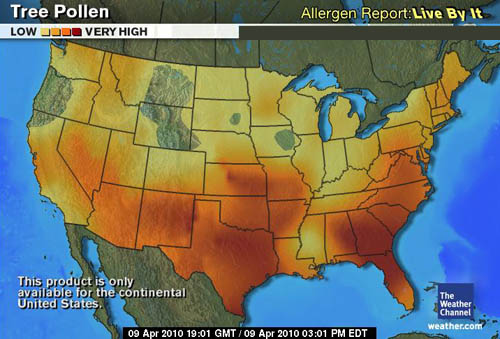It's the Trees
 [Image: Tree pollen map, brought to you by the Weather Channel].
[Image: Tree pollen map, brought to you by the Weather Channel].One of the most memorable posts on Pruned, I think, was written way back in September 2005, when Alex took a look at what he called "litter-free landscapes and the politics of pollen." He quoted horticulturalist Thomas Leo Ogren at length:
- In our urban landscapes we now have the most manipulated kind of city forest ever seen. In the past twenty years landscapers have grown inordinately fond of using male trees. In dioecious species (separate-sexed) there are separate male trees and separate female ones. Female trees and shrubs do not produce any pollen, ever, but they do produce messy seeds, fruits, old flowers, and seedpods. Landscapers and city arborists consider this female byproduct to be "litter", and they don’t like to see it lying on our sidewalks.
I was thus thrilled when Alex pointed out that Ogren had written an op-ed piece for the New York Times, revisiting these very ideas. "As certain trees burst into bloom in spring," Ogren writes, "their pollen wafts through the air in a wanton attempt to reach receptive blossoms."
- Millions of people with allergies pay the price, in sneezing, wheezing, coughing, drowsiness and itchy, watery eyes. They needn’t suffer so much. Cities could reduce the misery by planting street trees that produce very little pollen or none at all.
- Back in the 1950s, the most popular species planted in the United States was the native American elm, which sheds little pollen. Millions of these tall, stately trees lined the streets of towns and cities from coast to coast. Sadly, in the 1960s and ’70s, Dutch elm disease killed most of the elms, and many of them were replaced with species that are highly allergenic.
(Via Pruned).





Comments are moderated.
If it's not spam, it will appear here shortly!
Thank you for mentioning this. It's really interesting to consider the effects of planting different trees in cities. Slight changes can have such broad impacts on public health in densely populated areas. It's great to see people like Ogren bringing these kinds of opportunities to light.
Ah, the beautiful elm monoculture.
The male vs. female plant dilemma. A good example is the ginkgo. Many cities only plant males because the fruit of the female releases an objectionable odor when crushed. Of course, ginkgo fruit is edible so the city could encourage folks to Eat Street Trees! (shameless plug for localecology.org). We've written about the ginkgo (twice) and recommend Human Flower Project's Girl Trees of Beijing" post.
Finally, what are low allergy tree species? Check out Ogren's OPAL (Ogren Plant Allergy Scale) scale. He ranks the Red Maple 'Autumn Glory' cultivar as "the best" tree.
That post in Pruned you mention (Sept 2005)I've spread it all around since. I thought it described perfectly the wrong doings of capital, superficial knowledge and "not researched enough" techniques.
Thanks for the Beijing link, Georgia; very interesting use of old poetry and ceramics to support her case!
Post a Comment